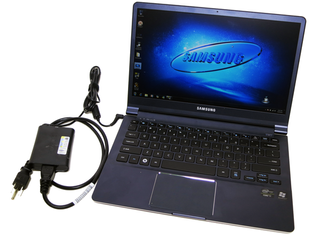Samsung's Series 9 13.3" Ultrabook For 2012: Thinner And Lighter
Samsung 13.3" Series 9: Better In 2012
The problem we've had with Intel's Ultrabook initiative is one of consistency. We've seen Ultrabooks we'd be happy to carry around, and others that bore more bulk than we expected. Because those more rotund models employed larger displays, though, they were still able to skate by with Ultrabook branding. That's watering down the concept, we think.
Samsung circumvents the controversy entirely with its 13.3" Series 9, updated for 2012, though. Nowhere on its product page does the company even mention Ultrabook. It boasts about half-inch thickness, of course, but also lets the SuperBright display, solid-state storage, and exceptional battery life enjoy time under the spotlight.

We put each of those highlights to the test and discovered that the new Series 9 excels in each case. It's both thinner and lighter than a MacBook Air, its screen is almost as vibrant as the vaunted third-gen iPad, its battery out-lasts competing compact notebooks, and its Ivy Bridge-based CPU and SATA 6Gb/s-capable SSD deliver snappy performance. By all accounts, this is what we were expecting when Intel first discussed Ultrabooks with us three generations ago. Finally, Samsung delivers with its 13.3" Series 9 (NP900X3C-A04US).
There's very little we don't like about this platform. Its keyboard and touchpad could use some refinement, we think, as they're both difficult to switch to from a desktop environment. But by far the hardest pill to swallow is this Ultrabook's price tag. This is no value-oriented contender. It's a flagship, and it sells for a hefty $1700 (yes, even without discrete graphics). That's $200 more than the most comparable MacBook Air. Fortunately, the fully decked-out SKU we're reviewing is but one option from the Series 9 family. If you're willing to step back to a 128 GB SSD and a Core i5-3317U, you shave a full $400 off the price tag and retain the 13.3" form factor, a great display, exceptional battery performance, and performance that does not disappoint.
Although it would have done bad things to pricing, it would have been nice to see Thunderbolt support from the Series 9. Maybe we're just amped up about the technology after hooking up a discrete graphics card via Thunderbolt in Echo Express Pro: Desktop Graphics In A Thunderbolt Chassis. Think about it though; the use of HD Graphics 4000 wouldn't matter all that much if you could hook up a desktop Radeon HD 7850 or GeForce GTX 660 whenever you were docked at home. We can dream, right?
Until then, Samsung's refreshed 13.3" Series 9 serves as a stellar example of what an Ultrabook should be, without being self-congratulatory about it. The company quietly refines its chassis, improves performance, and value-adds extras like a gigabit Ethernet dongle. We took notice, though, and we like what we see.
Stay on the Cutting Edge
Join the experts who read Tom's Hardware for the inside track on enthusiast PC tech news — and have for over 25 years. We'll send breaking news and in-depth reviews of CPUs, GPUs, AI, maker hardware and more straight to your inbox.
Current page: Samsung 13.3" Series 9: Better In 2012
Prev Page Battery Performance: Four Hours Of Real-World Use-
mayankleoboy1 Is the QS balance between quality/speed determined by any OEM customised driver ?Reply
Because this samsung notebook takes more time than other i7's in 'quality' setting, but lesser time in 'performance' settings.
-
mayankleoboy1 in the screen quality/brightness benchmark, why u no compare with the new rMBP ?Reply -
joytech22 esreverDon't samsung ultra books overheat a lot?What..? No. That's the dell's and I'm not even joking.Reply
I was watching a demo and their Dell XPS ultrabooks with GT640's in them continuously overheated during the demos and lowered the FPS catastrophically low.
They have these ultrabooks at my local Jb HiFi (Well.. the i5 version at least) and it was cool to the touch and very solid (I've noticed even Acer's ultrabooks don't feel flimsy as sh*t like their notebooks). -
Yargnit Looks awesome, but unfortunately the 'ASUS Zenbook Prime UX31A' simply trounces it on a price/performance ratio. If there was a base model out for under $1200, preferably at $1000 like the Asus it'd be a very solid option. But the Asus for $1000 is just such a better value that it kind of make this look like a weak effort, which is too bad because it actually looks like a solid system.Reply -
ojas BTW i wish you'd have included a desktop processor's QuickSync benchmark for reference...Reply -
ojas Hmmm...interesting, one of the most positive review's i've seen of an ultrabook-class notebook...i just have two questions:Reply
1)Is the touchpad annoying? Compared to Apple's touchpads, for example.
2)Can you keep it in your lap, sitting or lying down slightly (you know, with the notebook against your knees)? Or does it get too warm?
These two are deal breakers for me, personally. So is the keyboard, but you've clearly stated what's wrong with that (touchpad too, but just wanted to know if it's a noticeable annoyance). -
veroxious BTW why was the Asus UX31A not used in the comparative benchmarks? We have the same form factor, Ivy Bridge i7 processor, 256GB SSD BUT the Asus sports a Full HD IPS panel that really impressed me for less money.Reply -
cangelini mayankleoboy1in the screen quality/brightness benchmark, why u no compare with the new rMBP ?I haven't gone out to buy one yet :)Reply
Most Popular

